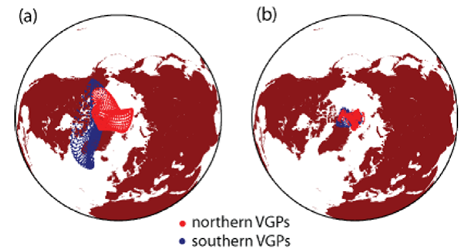Full name: Geocentric Axial Dipole hypothesis and the Geomagnetic Field
Period: 2013-…
Partners: DTU Space, Imperial College London (A. Muxworthy), University of Oxford (C. Mac-Niocaill), University of Iceland (M. Riishuus)
Budget: 3.5 mill DKK (Danish Research Council)
Summary: The core is the least well-understood part of the Earth. One can study its evolution and dynamics by examining temporal and spatial variations of the Earth’s magnetic field (the geomagnetic field). From magnetic observations taken by the Danish Ørsted satellite and its successors, we know that the recent geomagnetic field is dominated by a strong dipolar part, which is highly dynamic, changing in both direction and intensity in a chaotic manner. This is thought to reflect long- and short-term changes in fluid processes in the Earth’s liquid core.
Central to almost all interpretations of paleomagnetic data, whether for studies of paleomagnetic secular variation, for plate tectonic reconstructions, or for studies of paleoclimate is the hypothesis that – when averaged over time – the geomagnetic dipole is aligned with the rotation axis of the Earth: the so-called Geocentric Axial Dipole (GAD) hypothesis. However, this model is subject to systematic departures (non-dipole contributions) on 105-106 years, and the limits of the GAD hypothesis are not yet known. The aim of this project is (I) to test the robustness of the GAD hypothesis using the latest highly accurate palaeomagnetic methods on lava samples from Iceland; and (II) to determine a new and more precise geomagnetic Time Averaged Field model for the last 5–10 million years based on a combination of existing global data and the new paleomagnetic data. In 2013-2015, we carried out fieldwork in eastern/northern Iceland, sampling more than 2000 drill cores in Fljotsdalur and Jökuldalur. A similar number of cores were drilled in the valleys south of Akureyri in northern Iceland. Some of the results have been published in Døssing et al. (2016, EPSL), while the remainder are still being analyzed for paleodirections (VGP dispersion) and paleointensity.

VGP dispersion